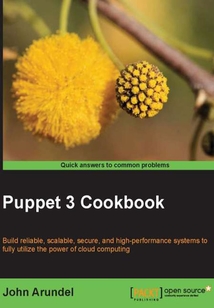舉報 

會員
Puppet 3 Cookbook
最新章節(jié):
Index
Puppet3CookbookiswritteninaCookbookstyle,showingyouhowtosetupandexpandyourPuppetinfrastructure.ItnotonlygivesyoueverythingyouneedtobecomeaPuppetexpert,butincludespowerfulcodesamplesandtechniquesdevelopedovermanyyearsofproductionexperience.Withit,you’llsavetimeandeffortbyautomatingtediousmanualprocesses,impressyourbossbydeliveringbetterbusinessvaluefromIT,andfuture-proofyourcareerbygettingtogripswiththenewtechnologiesrevolutionizingtheindustry."Puppet3Cookbook"isforanyonewhobuildsandadministersservers,especiallyinaweboperationscontext.ItrequiressomeexperienceofLinuxsystemsadministration,includingfamiliaritywiththecommandline,filesystem,andtextediting.Noprogrammingexperienceisrequired.
目錄(118章)
倒序
- coverpage
- Puppet 3 Cookbook
- Credits
- About the Author
- About the Reviewers
- www.PacktPub.com
- Support files eBooks discount offers and more
- Preface
- What this book covers
- What you need for this book
- Who this book is for
- Conventions
- Reader feedback
- Customer support
- Chapter 1. Puppet Infrastructure
- Introduction
- Installing Puppet
- Creating a manifest
- Managing your manifests with Git
- Creating a decentralized Puppet architecture
- Writing a papply script
- Running Puppet from cron
- Deploying changes with Rake
- Bootstrapping Puppet with Rake
- Automatic syntax checking with Git hooks
- Chapter 2. Puppet Language and Style
- Introduction
- Using community Puppet style
- Checking your manifests with puppet-lint
- Using modules
- Using standard naming conventions
- Using inline templates
- Iterating over multiple items
- Writing powerful conditional statements
- Using regular expressions in if statements
- Using selectors and case statements
- Using the in operator
- Using regular expression substitutions
- Chapter 3. Writing Better Manifests
- Introduction
- Using arrays of resources
- Using definitions
- Using dependencies
- Using tags
- Using run stages
- Using node inheritance
- Passing parameters to classes
- Using class inheritance and overriding
- Writing reusable cross-platform manifests
- Getting information about the environment
- Importing dynamic information
- Passing arguments to shell commands
- Chapter 4. Working with Files and Packages
- Introduction
- Making quick edits to config files
- Using Augeas to automatically edit config files
- Building config files using snippets
- Using ERB templates
- Using array iteration in templates
- Using GnuPG to encrypt secrets
- Installing packages from a third-party repository
- Building packages automatically from source
- Comparing package versions
- Chapter 5. Users and Virtual Resources
- Introduction
- Using virtual resources
- Managing users with virtual resources
- Managing users' SSH access
- Managing users' customization files
- Efficiently distributing cron jobs
- Using schedules to limit when resources can be applied
- Using host resources
- Using multiple file sources
- Distributing directory trees
- Cleaning up old files
- Auditing resources
- Temporarily disabling resources
- Chapter 6. Applications
- Introduction
- Managing Apache servers
- Creating Apache virtual hosts
- Creating Nginx virtual hosts
- Managing MySQL
- Managing Ruby
- Chapter 7. Servers and Cloud Infrastructure
- Introduction
- Building high-availability services using Heartbeat
- Managing NFS servers and file shares
- Using HAProxy to load-balance multiple web servers
- Managing firewalls with iptables
- Managing EC2 instances
- Managing virtual machines with Vagrant
- Chapter 8. External Tools and the Puppet Ecosystem
- Introduction
- Creating custom facts
- Adding external facts
- Setting facts as environment variables
- Importing configuration data with Hiera
- Storing secret data with hiera-gpg
- Generating manifests with puppet resource
- Generating manifests with other tools
- Testing your manifests with rspec-puppet
- Using public modules
- Using an external node classifier
- Creating your own resource types
- Creating your own providers
- Creating your own functions
- Chapter 9. Monitoring Reporting and Troubleshooting
- Introduction
- Doing a dry run
- Logging command output
- Logging debug messages
- Generating reports
- Producing automatic HTML documentation
- Drawing dependency graphs
- Understanding Puppet errors
- Inspecting configuration settings
- Index 更新時間:2021-04-09 23:52:48
推薦閱讀
- 性能測試從零開始
- AJAX and PHP: Building Modern Web Applications 2nd Edition
- 突破平面Premiere Pro 2022短視頻與視頻制作
- Zenoss Core Network and System Monitoring
- Python數(shù)據(jù)分析實戰(zhàn):從Excel輕松入門Pandas
- Blender 3D Architecture, Buildings, and Scenery
- Salesforce CRM: The Definitive Admin Handbook
- Vue 企業(yè)開發(fā)實戰(zhàn)
- 巧學(xué)巧用Flash CS6制作動畫
- 3D打印輕松實踐:從材料應(yīng)用到三維建模
- Plone 3 Theming
- Drupal 6 Site Blueprints
- Alias 2013工業(yè)設(shè)計完全自學(xué)一本通
- SEO搜索引擎優(yōu)化:基礎(chǔ)、案例與實戰(zhàn)(第2版)
- 深度學(xué)習(xí)圖像識別技術(shù):基于TensorFlow Object Detection API和OpenVINO? 工具套件
- 新印象:After Effects移動UI動效制作與設(shè)計精粹
- Drupal 7 Social Networking
- Pro/ENGINEER Wildfire 4.0中文版完全自學(xué)手冊
- 動手學(xué)推薦系統(tǒng):基于PyTorch的算法實現(xiàn)(微課視頻版)
- NetBeans Platform 6.9 Developer's Guide
- Rhino 8.0中文版完全自學(xué)一本通
- 圖表會說話:Excel數(shù)據(jù)可視化之美
- PowerPoint 2013從入門到精通
- Learning Drupal 6 Module Development
- Painter繪畫技法從入門到精通
- Tableau數(shù)據(jù)可視化分析從新手到高手
- SolidWorks 2018三維設(shè)計及應(yīng)用教程
- 中文版Photoshop淘寶網(wǎng)店設(shè)計入門與提高
- After Effects特效合成完全攻略
- Creo曲面設(shè)計教程(Creo 8.0中文版)

